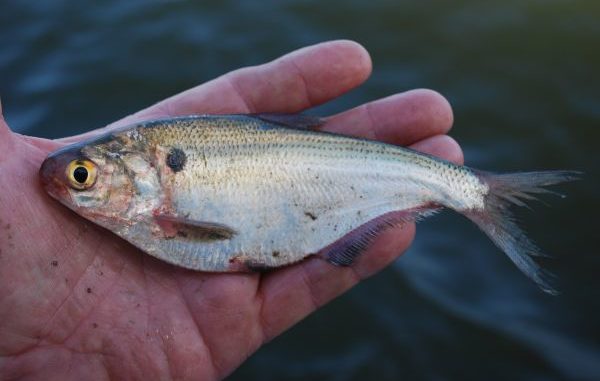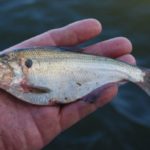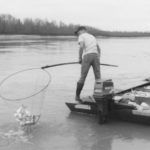
Why this species matters
Gizzard shad are under-appreciated fish in most places where they are found. That covers a lot of territory — virtually all lakes and rivers in the eastern United States.
They won’t take artificial lures. In fact, they are impossible to catch on a hook, even with natural bait.
As members of the large herring family, which includes saltwater sardines and menhaden, they have extremely oily flesh that is beset with huge numbers of tiny bones.
But we like them in Louisiana.
They are one of the best crawfish baits, and commercial fishermen pursue gizzard shad relentlessly wherever they occur in large enough numbers to make trying to catch them worthwhile.
Most are caught with simple but large, hand-held dip nets.
Gizzard shad are “rheotaxic,” meaning they are attracted to areas of strong currents. Some of these are man-made, such as pump outfalls.
Others are natural. The irregular shoreline of Louisiana’s three major rivers — the Red, the Atchafalaya and the Mississippi — create what shad dippers call “shad points,” where current is interrupted enough to speed it up slightly.
Dippers tie their boats next to the bank, bow upstream on such a point. There they spend the day, tirelessly sweeping the water with their dip nets in a downstream motion.
Some dips yield one fish or no fish. Others yield seven or eight shad. A day of backbreaking labor can yield over a thousand pounds of fish, all destined for sale as crawfish bait.
But Louisiana’s interest in gizzard shad isn’t confined to commercial fishermen. Sport fishermen find big blue catfish — those monsters over 25 pounds — like nothing better than a fresh gizzard shad, either cut in hunks or used whole.
A lot of shad also end up as being used as cut bait on catfish trotlines, commercial as well as recreational.
The gizzard shad’s scientific name is Dorosoma cepedianum. The genus name, Dorosoma, comes from Greek and means “lance body,” in reference to the long, slender shape very young gizzard shad have. The species name is in honor of Citoyen Lacépède, a French scholar who wrote the Histoire Naturelle des Poissons, the natural history of fishes.
Gizzard shad have the typical herring look: nondescript and silvery all over, with spineless fins.
It might only be mistaken for a few other freshwater fish. The skipjack herring and the rare Alabama shad can be eliminated by neither having a long, hair-like trailer extending from the back of the dorsal fin.
Both the gizzard shad and the threadfin shad have dorsal fin extensions, but a quick glance at their mouths will give their ID away. The gizzard shad’s mouth is subterminal, meaning it is located beneath the snout, giving it a blunt-nosed appearance.
The threadfin shad’s mouth is terminal, meaning it is located on the tip of the snout.
Another tattletale feature is that most of the fins of threadfin shad have noticeable yellow highlights.
Finally, the gizzard shad grows much larger than the threadfin shad. Any shad longer than 7 inches is almost certainly a gizzard shad.
Gizzard shad receive their name from their muscular gizzard-like stomach, which it uses to digest its adult diet of phytoplankton — microscopic, one-celled free-floating algae. The algae are “grazed” by the fish swimming with its mouth open, at the same time using its gill covers to pump even more water over its gills.
Plankton, including some zooplankton (microscopic animals), is strained from the water by the shads’ numerous, densely packed gill rakers, forward-pointing extensions on the arches of the shads’ gills.
They are good at what they do. Gizzard shad feeding has been pointed to as the culprit in so decimating zooplankton populations that few are left to nourish other fish that are more desirable for fishermen.
When this occurs — and even at other times — gizzard shad will feed on the organic remains of plants and animals in bottom sediments. There, they peck at the soft bottom and filter the muddy cloud through their gill rakers to glean anything digestible from the mud. Studies have shown that gizzard shad are able to digest 50 to 66 percent of the plant and animal matter in this mud.
This recycling back into the food chain of nutrients lost into bottom muds is one important contribution of gizzard shad to fisheries. The other is that young gizzard shad are often very numerous, and are heavily eaten by fish species important to fishermen.
Because of this, gizzard shad have been stocked in many reservoirs outside of their natural range in the eastern U.S. Unfortunately, gizzard shad grow so quickly they rapidly become too large for all but the very biggest predator fishes to feed on.
By the end of their first year of life, they are more than 5 inches long, and they reach 11 or more inches by year 3. Four to 6 years is their life span.
Because of this and their high spawning success, gizzard shad can make up 80 percent of all the fish flesh swimming in some reservoirs.
Females, age for age, are larger than males.
When their populations become this large, they become competitors for the food that young game fish need, rather than serving as food for these fish.
This has led biologists to look for predator species to stock that will eat adult gizzard shad.
Striped bass are the usual answer. There are two reasons they are better at controlling gizzard shad than largemouth bass.
First, they grow large enough to eat large shad. Secondly, unlike largemouths, they are an open-water fish, as are shad.
Striper stockings have had their own problems. Crappie fishermen in many reservoirs often loudly complain (even though the science does not support their claim) that stripers are eating all “their” crappie.
In Louisiana, gizzard shad begin spawning in late March when waters warm to 50 degree Fahrenheit and continue through July. Some can spawn at age 1, but most become sexually mature at 2 years old.
Shad spawning is a messy affair. During the evening and early night, male and female fish roll and tumble with each other in a mass near the water’s surface, releasing eggs and sperm.
Fertilization is random, and fertilized eggs quickly sink to the bottom, where they stick to anything solid.
Females spawn multiple times a season.
The eggs hatch in four days and, for a period of time, the larval shad are free-floating in the water.
Their numbers can be astounding. During one mid- to late June study period, gizzard shad and freshwater drum (aka gaspergou) made up almost 94 percent of all the larval fish floating down the Mississippi River near St. Francisville.
Taken out of water or held in a livewell, gizzard shad die quickly. But in the wild, they are tough, handling water temperatures as high as 95 degrees and as low as 32 degrees.
The IGFA world record for the species is a 4-pound, 6-ounce fish taken from Lake Michigan in 1996. No record exists of how this fish that doesn’t bite on hooks was caught.




